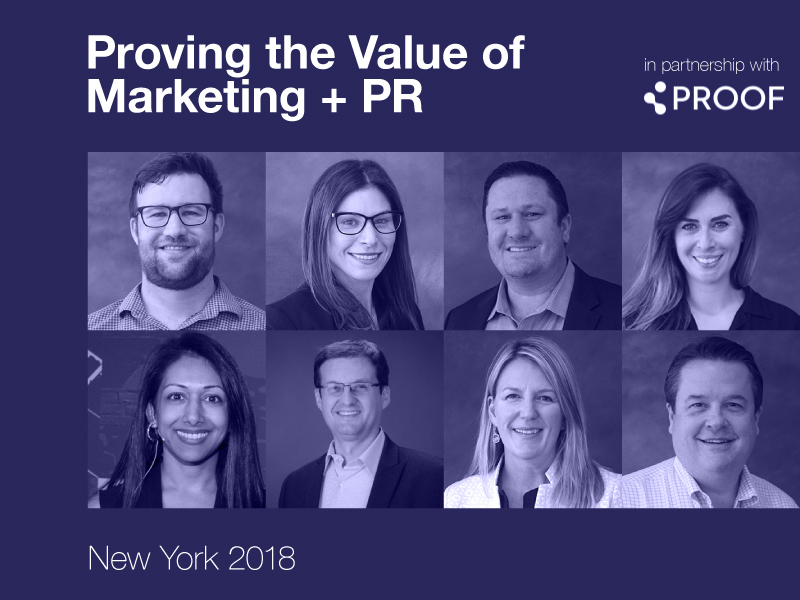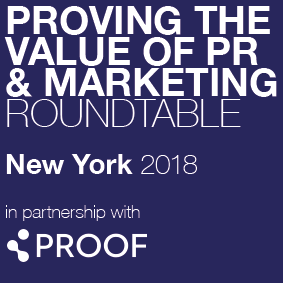Aarti Shah 27 Jun 2018 // 3:07PM GMT

Every so often, a public relations executive recalls, with some derision, when the profession’s impact was measured by “the thud factor” — or the impact the clip book made when it landed on the client’s desk. The thud factor, however, has stubbornly endured over the years, morphing its form but still ultimately measuring the perception of impact. Metrics — like impressions, awareness and clip counts — are not only ubiquitous, but also underscore the gulf between how the PR industry and CEOs define value.
The Holmes Report, in partnership with Proof Analytics, held a closed-door salon in New York on May 21. Several of the industry’s forward-looking thinkers came together to explore how the industry can ensure its survival as the pressures to prove business value and justify investment mount with unprecedented vigor. This roundtable was part two of a series of roundtables on the imminent future of the PR industry. Part one can be found here
The Panel:
Brent Diggins, Managing director for measurement + analytics, Allison + Partners
Dan Simion, North America managing director of data science, Accenture
Diana Wong, Head of global corporate communications, RSA
Eli Draluk, VP data/analysis, Digitas North America
Elyse Margolis, Pharma practice Leader, the W2O Group
Erin Lanuti, Global performance solutions Officer, Perfomics
Mark Stouse, CEO, Proof Analytics
Marissa O. Michel, US territory crisis leader, PwC
Moderator: Aarti Shah, Senior Editor/COO, The Holmes Report

‘Everything Needs To Be Attributable To Sales’
“The fact is that marketing and communications deliver powerful incremental business impact that the other parts of the organization could not deliver for themselves,” said Proof founder/CEO Mark Stouse. “The problem is that marketing impact has been unproven in most businesses, leading to an incredibly dysfunctional planning and budgeting process.
Yet some communications teams feel pulled into different directions with seemingly conflicting budget priorities.
“We have to support the business units because if we’re not selling, we’re not moving the needle on the objectives,” said RSA’s Diana Wong. “But there’s also the bigger corporate message around — who is RSA Security and to ensure we’re a trusted partner.”
“We’re seeing a big shift, across multiple categories, to a new mindset where everything needs to be attributable to sales,” said Perfomics’ Lanuti. “There’s a re-prioritization of all the marketing tactics towards the biggest yield against that. So, whether it’s electronics, consumer health or CPG, we’re seeing a doubling down on what’s driving sales and de-prioritizing things like brand reputation.”
While this holds true for relatively low-risk, inexpensive purchases, enterprise customers — who often have their professional reputations at stake when making big buying decisions — tend to rely on a brand’s reputation to mitigate that risk.
“The confidence and trust components of brand correlate very strongly with closing bigger deals and accelerating that sales cycles,” Proof’s Stouse said. “And one of the big challenges with B2B is this lag time can obfuscate your ability to connect the dots. This is where the multi-touch attribution model has failed, it has failed to deliver proof of anything because of the time lag.”
Ultimately, Lanuti, said third-party content continues to drive business metrics.
“What we’ve found is across every category, across every country, leveraging what I would deem brand building PR, does drive those metrics,” Lanuti said. “We consistently see 25% better performance when we leverage earned. We see faster conversion down the funnel. We see more qualified traffic going to the brand pages. And so as we talk about brand credibility and reputation, we need to open up the conversation to also talk about the core of PR, which is getting that high quality, relevant, third-party content that will generate the business result we are looking for.”
‘We Need More Reputation Protection’
Yet when an organization is amid a crisis, the calculus shifts as trust and confidence have been compromised and the repercussions become evident.
“When I’m there, the conversation is - we need more communications, we need more reputation protection,” PwC’s crisis practice Marissa Michel said. “And in a crisis, the impact is reflected in the share value.”
“We have collected the customized analytics for our clients so if, or when, a crisis happens, there’s already a deep understanding of what their ecosystem looks like,” said W2O’s Margolis.
In the moment, a crisis may portend reputation doom, but recent examples have shown consumers tend not to penalize a brand in the long-run. United Airlines, despite multiple firestorms — particularly on social media — only suffered short-term revenue impact and its stock price rebounded even higher quickly thereafter.
“The factor that comes into play here is elasticity of the supply and demand,” Stouse said. “You could be furious at United and if they still have the best price and the best time to get you to that destination — you’re going to take their plane. They learned that in spades and it’s one of the reasons they are spending a lot of time and effort on customer experience, but not on reputation. The inelastic nature of their industry means they almost don’t have to care.”
“The airline industry is really unique in that sense,” Michel countered. “I do think your point is absolutely valid, but it would be dangerous to take apply those lessons to other sectors.”
“Absolutely. The one topic that nullifies what I said earlier about elasticity or inelasticity — is the issue of safety,” Stouse said. “As soon as it become existential to a person’s survival, whatever that could mean. The part that really cut against Uber, more than anything else, were the assaults by Uber drivers, as opposed to they’re icky as a company.”
“And healthcare, I mean the highs and lows of reputational impact are instantaneous and very sticky and there’s also the halo effect where your neighbour is in trouble and you are instantaneously taking a hit as well,” Margolis said.
“When a crisis happens, everyone freaks out, then they spend way too much money,” Digitas’ Draluk said. “And half the time when they come to us in a crisis, they’re not even real crises. They’re just people saying mean stuff about them on the internet, which has people have been doing since 1994. So one of the big value propositions that we built was around the concept of CFTD — or calm the ‘f-word’ down. Using social data and public news data, we were able to say this is or isn’t a potential issue and whether there will be reputational shifts or sales impact.”

‘The Industry Has Many Reasons to Feel Good About Itself’
When it comes to justifying marketing or communications spend, most of the participants agree they are tasked with aligning their goals to business objectives — but no clear consensus emerged on how to effectively measure these outcomes.
“A lot of organizations don’t fundamentally understand where PR or marketing impacts the purchase journey,” said Allison’s Brent Diggins. “They don’t understand their customers very well, so there’s no clarity around whether the impact is at the top of the funnel, the consideration stage or somewhere further down the line.”
“Most marketing and PR teams that are doing competent work are delivering far more value than the business leaders appreciate,” Stouse added. “If you move through the data layer and get to the analytics layer, you’ll find yourself in a very strong place. But it doesn’t mean things are perfect and that you won’t have to rebalance your portfolio. But for us, it’s been relatively rare to find results that are catastrophically awful. In most cases, it’s clear the industry has many reasons to feel good about itself.”
“I developed a technology for Publicis Group called Conversation to Commerce and when we were doing that we met with CEOs and CMOs all over the world,” Lanuti said. “I didn’t meet a single one who didn’t understand the value of PR. Their frustration was they couldn’t tangibly show the business impact of it. The key is really democratizing the data and analytics because right now it’s held in pockets and not transparently given to everyone in way to level the playing field.”
“People are terrified,” said Digitas’ Draluk. “I worked in a traditional PR agency before switching to the media side. There were a lot of conversations around KPIs that went like this - ‘our clients are happy, things are moving along. Let’s not upset the apple cart.’ And sure, their KPIs would work until someone comes and upends the client’s budget or the client decides to move the business elsewhere. The fear isn’t working for the industry.”
“But CEOs might not see the value in marketing analytics,” said Allison’s Diggins. “That’s, in part, because they’ve been burned in other places. We’re talking about PR and marketing here, but they have been burned by putting hundreds of millions of dollars into data, infrastructure, hiring scientists. And three or five years later, they’ve put $100m down the drain. So, we do need to show results pretty quickly.”
‘If the Data Isn’t Connecting, That Becomes Very Clear’
Even though we’re amid an era of data deluge, there’s considerable difficulty in drawing conclusions from mounds of unstructured data. Compounding this challenge is aligning organizational stakeholders around shared goals.
“It’s not just about structured data, unstructured data — it’s more around the common objectives,” said Accenture’s Simion. “You have to decide what you’re going after and have a solid stream of data that supports it. What’s the objective and what’s the underlying data to support and measure that objective? And the data must be systematically trackable because measurements must be consistent over time.”
“Having these disparate pools of data really works against a company,” PwC Michel said. “When you’re trying to figure out what’s moving the needle on share price in the midst or the aftermath of a crisis, and if the data isn’t connecting, that becomes very clear.”
“Marketing and PR tend to instrument that which they are already doing in an effort to prove that what they are doing matters,” Proof’s Stouse said. “What’s missing is the contextual data. One of the great scandals right now in these two professions is that most companies have almost no regular audience data at all. They will be able to say how all these different things they’re doing are performing digitally but in terms of real audience awareness, real confidence or trust — they have almost nothing. They are at the other side of the world from, say, political PR which they know everything.”
“The PR agencies need to be looking at data and analytics and mapping the type of content to the audience and the mindset as to where they are in the funnel,” Lanuti said. “And it’s not clear whether they have the tools, technology or skill-sets to do that. But I believe that’s what’s caused what I would say is a hunger games between ad agencies, the PR agencies and the media agencies.”
‘It’s Really Important to Close the Loop’
The business model at PwC and Accenture often means those consultants are starting their organizational relationships at the board-level. The participants from those organizations addressed how this impacts the way their services are ultimately evaluated — especially compared to PR.
Accenture’s Simion noted the while management consultancies benefit from boardroom relationships, the challenge for such firms is ensuring the ideas are actually executed.
“For us, it’s really important to close the loop and implement the recommendations so we’re not just doing another nice deck on, say, change management,” Simion said.
“It feels a bit like comparing apples to a completely other food type — not even fruit — because when we come in a crisis has already happened,” PwC’s Michel said. “I’ve never shown up at a crisis and not had the PR agency already on board. Maybe it’s not the right PR agency because often times your existing agency may not be the one you want to handle the crisis. But we’re coming in at the C-level with a broad set of services and bringing in an army of technicians. And what that gets you, perhaps counter-intuitively, is less nickel and dimed on metrics because there’s trust from the C-level.”
The roundtable was held in partnership with Proof Analytics in New York on May 21. This roundtable was part two of a series of roundtables on the imminent future of the PR industry. Part one can be found here.


































.jpg)
































